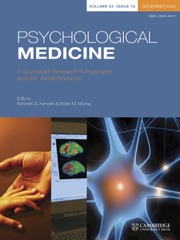Crossref Citations
This article has been cited by the following publications. This list is generated based on data provided by
Crossref.
Edwards, Bethany G.
Carre, Jessica R.
and
Kiehl, Kent A.
2019.
A review of psychopathy and Cluster B personality traits and their neural correlates in female offenders.
Biological Psychology,
Vol. 148,
Issue. ,
p.
107740.
Haselager, Pim
and
Mecacci, Giulio
2020.
Superethics Instead of Superintelligence: Know Thyself, and Apply Science Accordingly.
AJOB Neuroscience,
Vol. 11,
Issue. 2,
p.
113.
Johanson, Mika
Vaurio, Olli
Tiihonen, Jari
and
Lähteenvuo, Markku
2020.
A Systematic Literature Review of Neuroimaging of Psychopathic Traits.
Frontiers in Psychiatry,
Vol. 10,
Issue. ,
Guirado, Ramon
Perez-Rando, Marta
Ferragud, Antonio
Gutierrez-Castellanos, Nicolas
Umemori, Juzoh
Carceller, Hector
Nacher, Juan
and
Castillo-Gómez, Esther
2020.
A Critical Period for Prefrontal Network Configurations Underlying Psychiatric Disorders and Addiction.
Frontiers in Behavioral Neuroscience,
Vol. 14,
Issue. ,
Hofhansel, Lena
Weidler, Carmen
Votinov, Mikhail
Clemens, Benjamin
Raine, Adrian
and
Habel, Ute
2020.
Morphology of the criminal brain: gray matter reductions are linked to antisocial behavior in offenders.
Brain Structure and Function,
Vol. 225,
Issue. 7,
p.
2017.
Ribeiro da Silva, Diana
Rijo, Daniel
and
Salekin, Randall T.
2020.
Psychopathic traits in children and youth: The state-of-the-art after 30 years of research.
Aggression and Violent Behavior,
Vol. 55,
Issue. ,
p.
101454.
Calzada‐Reyes, Ana
Alvarez‐Amador, Alfredo
Galán‐Garcia, Lidice
and
Valdés‐Sosa, Mitchell
2021.
Electroencephalographic and morphometric abnormalities in psychopath offenders.
Behavioral Sciences & the Law,
Vol. 39,
Issue. 5,
p.
597.
Saladino, Valeria
Lin, Hannah
Zamparelli, Elisa
and
Verrastro, Valeria
2021.
Neuroscience, Empathy, and Violent Crime in an Incarcerated Population: A Narrative Review.
Frontiers in Psychology,
Vol. 12,
Issue. ,
Tesli, Natalia
Rokicki, Jaroslav
Maximov, Ivan I
Bell, Christina
Hjell, Gabriela
Gurholt, Tiril
Fischer-Vieler, Thomas
Bang, Nina
Tesli, Martin
Westlye, Lars T
Andreassen, Ole A
Melle, Ingrid
Agartz, Ingrid
Rasmussen, Kirsten
Johansen, Ragnhild
Friestad, Christine
and
Haukvik, Unn K
2021.
White Matter Matters: Unraveling Violence in Psychosis and Psychopathy.
Schizophrenia Bulletin Open,
Vol. 2,
Issue. 1,
Jalava, Jarkko
Griffiths, Stephanie
Larsen, Rasmus Rosenberg
and
Alcott, B. Emma
2021.
Is the Psychopathic Brain an Artifact of Coding Bias? A Systematic Review.
Frontiers in Psychology,
Vol. 12,
Issue. ,
Lenzen, Laura M.
Donges, Maximilian R.
Eickhoff, Simon B.
and
Poeppl, Timm B.
2021.
Exploring the neural correlates of (altered) moral cognition in psychopaths.
Behavioral Sciences & the Law,
Vol. 39,
Issue. 6,
p.
731.
Pujol, Jesus
Blanco-Hinojo, Laura
Gallart, Lluís
Moltó, Luís
Martínez-Vilavella, Gerard
Vilà, Esther
Pacreu, Susana
Adalid, Irina
Deus, Joan
Pérez-Sola, Víctor
and
Fernández-Candil, Juan
2021.
Largest scale dissociation of brain activity at propofol-induced loss of consciousness.
Sleep,
Vol. 44,
Issue. 1,
De Brito, Stephane A.
Forth, Adelle E.
Baskin-Sommers, Arielle R.
Brazil, Inti A.
Kimonis, Eva R.
Pardini, Dustin
Frick, Paul J.
Blair, Robert James R.
and
Viding, Essi
2021.
Psychopathy.
Nature Reviews Disease Primers,
Vol. 7,
Issue. 1,
Pujol, Jesus
Blanco-Hinojo, Laura
Macia, Didac
Martínez-Vilavella, Gerard
Deus, Joan
Pérez-Sola, Víctor
Cardoner, Narcís
Soriano-Mas, Carles
and
Sunyer, Jordi
2021.
Differences between the child and adult brain in the local functional structure of the cerebral cortex.
NeuroImage,
Vol. 237,
Issue. ,
p.
118150.
Orsolini, Laura
Cicolini, Angelica
Salvi, Virginio
and
Volpe, Umberto
2022.
The “Well-Dressed Snake Personality”: An Insight into Narcissistic/Psychopathic Personalities.
Journal of Psychology and Psychotherapy Research,
Vol. 9,
Issue. ,
p.
104.
Gaines, Katy Drorit
2022.
The Complexity of Psychopathy.
p.
545.
Tostlebe, Jennifer J.
and
Pyrooz, David C.
2022.
Psychopathy and Criminal Behavior.
p.
311.
Gou, Ningzhi
Lu, Juntao
Zhang, Simei
Liang, Xiaoxi
Guo, Huijuan
Sun, Qiaoling
Zhou, Jiansong
and
Wang, Xiaoping
2022.
Structural Deficits in the Frontotemporal Network Associated With Psychopathic Traits in Violent Offenders With Schizophrenia.
Frontiers in Psychiatry,
Vol. 13,
Issue. ,
Bell, Christina
Tesli, Natalia
Gurholt, Tiril P.
Rokicki, Jaroslav
Hjell, Gabriela
Fischer-Vieler, Thomas
Melle, Ingrid
Agartz, Ingrid
Andreassen, Ole A.
Rasmussen, Kirsten
Johansen, Ragnhild
Friestad, Christine
and
Haukvik, Unn K.
2022.
Associations between amygdala nuclei volumes, psychosis, psychopathy, and violent offending.
Psychiatry Research: Neuroimaging,
Vol. 319,
Issue. ,
p.
111416.
Pujol, Jesus
Blanco-Hinojo, Laura
Ortiz, Héctor
Gallart, Lluís
Moltó, Luís
Martínez-Vilavella, Gerard
Vilà, Esther
Pacreu, Susana
Adalid, Irina
Deus, Joan
Pérez-Sola, Víctor
and
Fernández-Candil, Juan
2022.
Mapping the neural systems driving breathing at the transition to unconsciousness.
NeuroImage,
Vol. 246,
Issue. ,
p.
118779.




